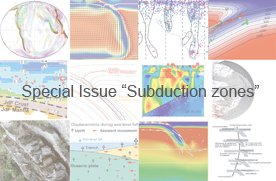Segmentation of the Izu-Bonin and Mariana slabs based on the analysis of the Benioff seismicity distribution and regional tomography results
Abstract. We present a new model of P and S velocity anomalies in the mantle down to a depth of 1300 km beneath the Izu-Bonin and Mariana (IBM) arcs. This model is derived based on tomographic inversion of global travel time data from the revised ISC catalogue. The results of inversion are thoroughly verified using a series of different tests. The obtained model is generally consistent with previous studies by different authors. We also present the distribution of relocated deep events projected to the vertical surface along the IBM arc system. Unexpectedly, the seismicity forms elongated vertical clusters instead of horizontal zones indicating phase transitions in the slab. We propose that these vertical seismicity zones mark zones of intense deformation and boundaries between semi-autonomous segments of the subducting plate. The P and S seismic tomography models consistently display the slab as prominent high-velocity anomalies coinciding with the distribution of deep seismicity. We can distinguish at least four segments which subduct differently. The northernmost segment of the Izu-Bonin arc has the gentlest angle of dipping which is explained by backward displacement of the trench. In the second segment, the trench stayed at the same location, and we observe the accumulation of the slab material in the transition zone and its further descending to the lower mantle. In the third segment, the trench is moving forward causing the steepening of the slab. Finally, for the Mariana segment, despite the backward displacement of the arc, the subducting slab is nearly vertical. Between the Izu-Bonin and Mariana arcs we clearly observe a gap which can be traced down to about 400 km in depth. Based on joint consideration of the tomography results and the seismicity distribution, we propose two different scenarios of the subduction evolution in the IBM zone during the recent time, depending on the reference frame of plate displacements. In the first case, we consider the movements in respect to the Philippine Plate, and explain the different styles of the subduction by the relative backward and forward migrations of the trench. In the second case, all the elements of the subduction system move westward in respect to the stable Asia. Different subduction styles are explained by the "anchoring" of selected segments of the slab, different physical properties of the subducting plate and the existence of buoyant rigid blocks related to sea mount and igneous provinces.






